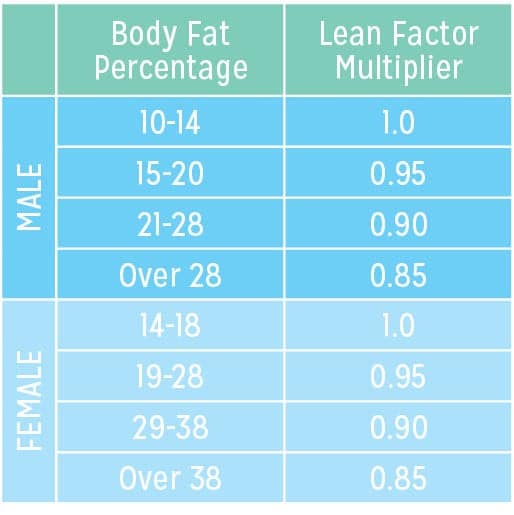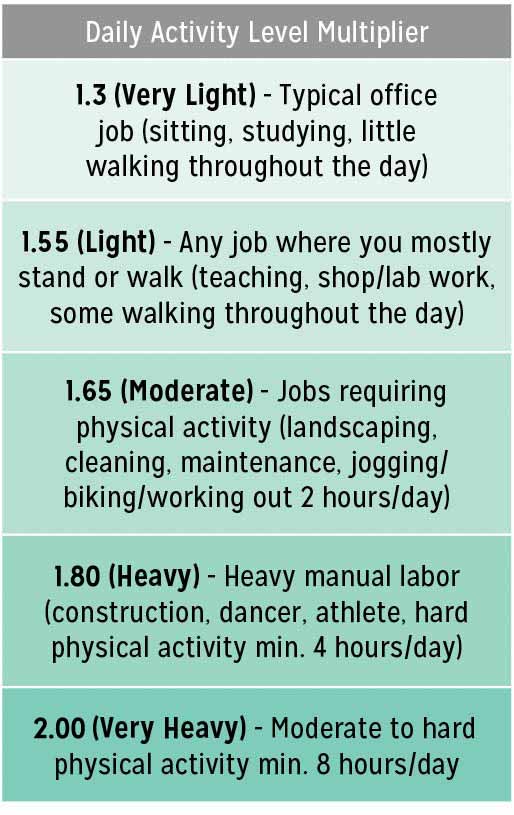The cornerstone of any good fitness plan is getting your diet right, and to do that, the first thing you need to do is to determine what your daily calorie needs are.
There are a lot of different online calculators you can use to find your daily calorie need. Some of them are ok, but most of them oversimplify the calculation by only using your age, weight, and gender. If you are a fitness nerd like me, you will probably want to know the correct scientific way of calculating what your daily calorie needs are.
It’s a very easy 5-step process. I have used my own data in the example below to show you how I work out what my daily calorie needs are.

How to calculate your daily calorie needs
Step 1: Find your body weight in kilograms (if you live in the US, just divide your weight in pounds by 2.2 to get your weight in kilograms).
Step 2: Multiply your weight in kilograms by 0.9 if you are a woman or 1.0 if you are a man.
Step 3: Multiply by 24
Step 4: Multiply by your “Lean Factor” from the table below (read on to learn how to find your body fat percentage if you don’t know it)

Example using my stats: 61 kg (134.5 lbs.) x 0.9 (female) x 24 x 0.95 (20% body fat) = 1252
This number is called your Basal Metabolic Rate (BMR). It’s how many calories you would burn in a day if you just lay on the couch all day and did nothing. To find out how many calories you actually burn in a day, you need to multiply with your “Activity Modifier” from the table below.
Step 5: Multiply by Activity Modifier

My daily calorie need would be: 1252 (my BMR) x 1.55 (Light Activity) = 1940 calories/day
As you can see, calculating your daily calorie needs is actually pretty simple, as long as you know your body fat percentage. Most gyms should be able to measure that for you, or a trainer can give you a very good estimate just by looking.
You can also use a tape measure and this online calculator to estimate your body fat percentage. It’s not as accurate, but you really only need an approximate number, so it should be good enough.
The main mistake people make when using this calculation is to overestimate their activity level. Even though I live a very active lifestyle and work out almost every day, I still only use the “Light Activity” multiplier. And that may even be on the high side because I also spend a lot (too much) time in front of a computer.
The higher multipliers are for people who use their bodies almost constantly throughout the day, like construction workers, pro athletes, etc.
If you are pretty fit and active, you should probably use the “Light” or “Very Light” multiplier. If you are just starting a fitness program, use the “Very Light” multiplier.
Now that you know how many calories you burn in a day, the next step is to decide if you want to lose or gain weight. If you are trying to lose weight, I recommend you eat around 400-500 calories less than you burn each day. That should lead to a weight loss of about 1 lbs. per week, which is a very healthy and sustainable rate.
If you want to gain muscle, start out at 500 calories/day more than you burn and see what happens. If you find that you are also putting on a little too much fat, decrease your calories slightly.
To make sure that you reach your daily calorie targets, it’s a good idea to follow a meal plan. You can either create your own or simply pick one from my meal plan library.
Good luck with your fitness program! If you need a little more help working out your daily calorie needs or anything else, you can always contact me for online training and meal plans.
Suggested next post: How To Lose Weight When You Live With Diabetes
If you liked this post, please sign up for our newsletter (and get a sign-up bonus) in the form below. We send out a weekly newsletter with the latest posts and recipes from Diabetes Strong.






0 Comments